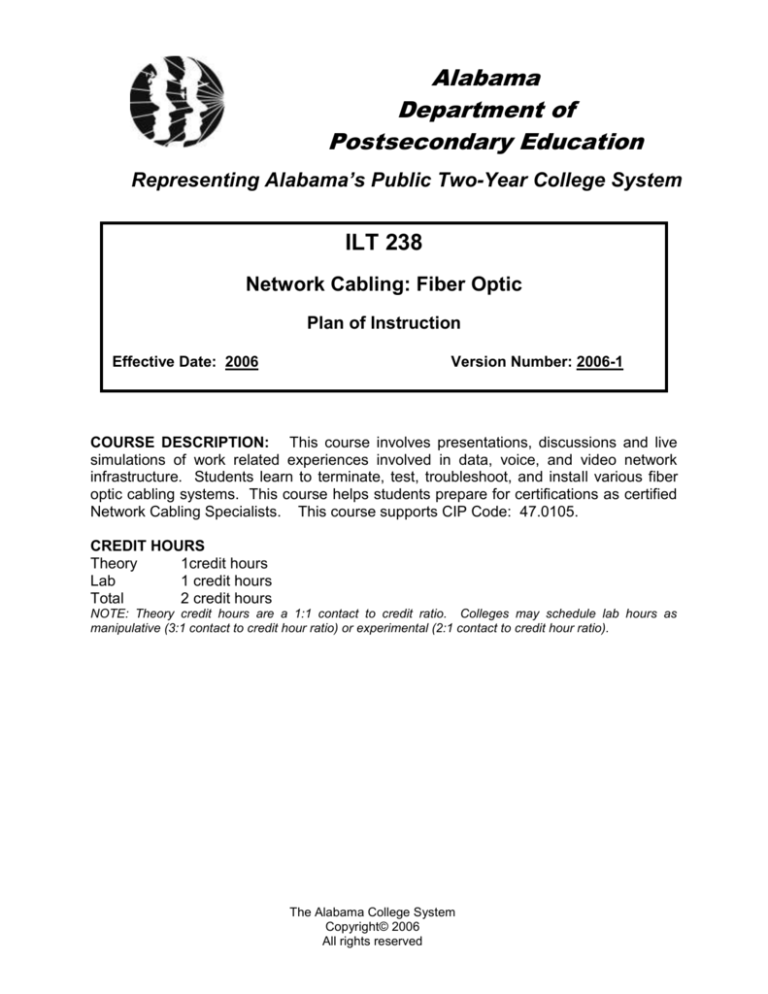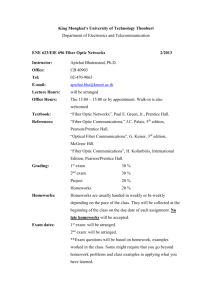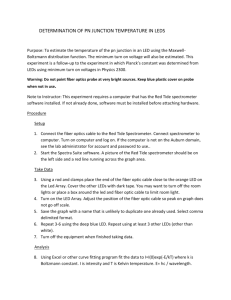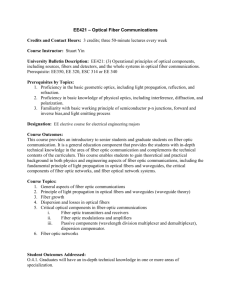
Alabama
Department of
Postsecondary Education
Representing Alabama’s Public Two-Year College System
ILT 238
Network Cabling: Fiber Optic
Plan of Instruction
Effective Date: 2006
Version Number: 2006-1
COURSE DESCRIPTION: This course involves presentations, discussions and live
simulations of work related experiences involved in data, voice, and video network
infrastructure. Students learn to terminate, test, troubleshoot, and install various fiber
optic cabling systems. This course helps students prepare for certifications as certified
Network Cabling Specialists. This course supports CIP Code: 47.0105.
CREDIT HOURS
Theory
1credit hours
Lab
1 credit hours
Total
2 credit hours
NOTE: Theory credit hours are a 1:1 contact to credit ratio. Colleges may schedule lab hours as
manipulative (3:1 contact to credit hour ratio) or experimental (2:1 contact to credit hour ratio).
The Alabama College System
Copyright© 2006
All rights reserved
Network Cabling – Fiber Optic
ILT 238
PREREQUISITE COURSES
Determined by college unless stated otherwise
CO-REQUISITE COURSES
Determined by college unless stated otherwise
INDUSTRY/PROFESSIONAL COMPETENCIES
Explain concepts related to fiber optics.
Use optical test equipment to determine continuity.
Match sources and detectors.
Describe tools used for fiber optic termination.
Terminate fiber optic cable.
Describe various types of fiber optic connectors.
Describe topologies and standards for cabling according to TIA/EIA 569-A for
commercial buildings.
Describe topologies and standards for cabling according to TIA/EIA 570 for
single residence and multi-tenant residences buildings.
Placing fiber optic cable for optimum function.
Use instruments to test and troubleshoot fiber optic cabling systems.
Describe concepts related to the profession of network cabling specialists.
GENERAL INSTRUCTIONAL OBJECTIVES
Cognitive objective - comprehend foundational knowledge of network cabling.
Psychomotor objective - apply foundational knowledge of network cabling.
INDUSTRY/PROFESSIONAL COMPETENCIES/STUDENT PERFORMANCE
Unless otherwise indicated, evaluation of student’s attainment of cognitive and
performance objectives is based on knowledge gained from this course. During
performance evaluations, students will be provided necessary tools, equipment,
materials, specifications, and any other resources necessary to accomplish the task.
Specifications may be in the form of, but not limited to, manufacturer’s specifications,
technical orders, regulations, national and state codes, certification agencies, locally
developed lab assignments, or any combination of specifications.
.
ACS Copyright© 2006
All rights reserved
2
Network Cabling – Fiber Optic
ILT 238
MODULE A – FIBER OPTIC CONCEPTS
INDUSTRY/PROFESSIONAL
COMPETENCIES
A1.0 Explain concepts related to
fiber optics. (B)
STUDENT PERFORMANCE OBJECTIVES
A1.1 This competency is measured cognitively.
ENABLING OBJECTIVES
A1.1.1
A1.1.2
A1.1.3
A1.1.4
A1.1.5
A1.1.6
A1.1.7
A1.1.8
A1.1.9
A1.1.10
Define terms associated with fiber optics.
Explain the historical development of fiber optics.
Give examples of light communication systems.
Describe the parts of fiber optic cable.
Describe the characteristics of light.
Describe operational wavelengths of fiber optic cable.
Describe factors related to the propagation of light.
Describe factors related to attenuation.
Describe bandwidth for fiber optic cable.
Describe dispersion as related to fiber optic cable.
KSA
Indicator
A
A
A
a
B
B
B
B
B
B
MODULE B – FIBER OPTIC CABLING
INDUSTRY/PROFESSIONAL
COMPETENCIES
B1.0 Use optical test equipment to
determine continuity. (2c)
STUDENT PERFORMANCE OBJECTIVES
B1.1 Given fiber optic cable and test equipment,
determine the continuity of fiber optic cable.
KSA
ENABLING OBJECTIVES
Indicator
B1.1.1 Identify the structure, characteristics and types of fiber optic cables.
a
B1.1.2 Match a single and multimode cable with its typical application.
c
B1.1.3 Describe characteristics of loose tube and tight buffer cables.
a
B1.1.4 Explain the process of stripping a light guide building cable.
b
B1.1.5 Describe the characteristics of ribbon cable.
a
B1.1.6 Differentiate between two-fiber zip cords and patch cords.
c
B1.1.7 Differentiate between mandatory and advisory terms.
B
B1.1.8 Describe color code standards for commercial applications.
B
B1.1.9 Differentiate between conductive, non-conductive, and composite cable as
c
per the NEC code.
B1.1.10 Describe typical labeling methods for fiber optic cables.
c
B1.1.11 Given a cabling substitution chart recommend a correct cable substitution.
C
ACS Copyright© 2006
All rights reserved
3
Network Cabling – Fiber Optic
ILT 238
MODULE C – SOURCES AND DETECTORS
INDUSTRY/PROFESSIONAL
COMPETENCIES
C1.0 Match sources and detectors.
(3c)
STUDENT PERFORMANCE OBJECTIVES
C1.1
Given various types of fiber optic cable, match
the sources and detectors to the proper type of
cable.
KSA
ENABLING OBJECTIVES
Indicator
C1.1.1
Define source as it pertains to fiber optic cable.
A
C1.1.2
Describe the operating characteristics of sources.
B
C1.1.3
Identify the two primary sources used in fiber optic systems.
A
C1.1.4
Describe safety precautions taken when dealing with optical sources.
B
C1.1.5
Describe the development of effective sources for fiber optic systems.
B
C1.1.6
Compare the two types of sources in terms of effective range, light
emission patterns, cost, output power, and mean time between failures.
B
C1.1.7
Define detector as it pertains to a fiber optic system.
A
C1.1.8
Identify the two primary types of optical detectors.
A
C1.1.9
Identify operating characteristics of detectors.
B
C1.1.10 Match an optical detector with its recommended source.
C
C1.1.11 Match an optic detector and source with their recommended type of fiber
C
optic cable.
C1.1.12 Identify electro static discharge and the procedures to follow when
b
handling sources and detectors.
C1.1.13 Describe advantages and disadvantages of fiber optic cabling systems
B
as compared to copper cabling systems.
MODULE D – FIBER OPTIC TERMINATION TOOLS
INDUSTRY/PROFESSIONAL
COMPETENCIES
D1.0 Describe tools used for fiber
optic termination. (c)
STUDENT PERFORMANCE OBJECTIVES
D1.1 This competency is measured cognitively.
NOTE: Termination activities occur as part of Module E.
KSA
ENABLING OBJECTIVES
Indicator
D1.1.1 Explain safety considerations terminating fiber optic cable.
B
D1.1.2 Describe safety considerations for various termination tools and
B
instruments.
D1.1.3 Match the tool to its proper use for specified fiber termination activities.
c
D1.1.3 Describe the purpose and use of the fiber optic disposal unit.
c
D1.1.4 Describe safety considerations and handling precautions for fiber optic
B
chemicals.
ACS Copyright© 2006
All rights reserved
4
Network Cabling – Fiber Optic
ILT 238
MODULE E – TERMINATING FIBER OPTIC CABLE
INDUSTRY/PROFESSIONAL
COMPETENCIES
E1.0 Terminate fiber optic cable.
(3c)
STUDENT PERFORMANCE OBJECTIVES
E1.1 Terminate SC and ST fiber optic connectors on a
light guide building cable and patch cable using
anaerobic methods of termination and test for
continuity.
KSA
ENABLING OBJECTIVES
Indicator
E1.1.1 Define anaerobic fiber termination.
A
E1.1.2 Describe the steps for terminating and testing termination of fiber optic
b
cable.
E1.1.3 Explain the process of measuring attenuation using a power meter and
b
light source.
E1.1.4 State the acceptable attenuation values for fiber optic terminations.
A
E1.1.5 Explain safety procedures when working with fiber optic cable.
c
E1.1.6 Explain correct procedures for disposal of loose fiber during cleaving.
b
MODULE F – FIBER OPTIC SYSTEM COMPONENTS
INDUSTRY/PROFESSIONAL
COMPETENCIES
F1.0 Describe various types of
fiber optic connectors. (B)
STUDENT PERFORMANCE OBJECTIVES
F1.1 This competency is measured cognitively.
ENABLING OBJECTIVES
F1.1.1
F1.1.2
F1.1.3
F1.1.4
F1.1.5
F1.1.6
F1.1.7
F1.1.8
F1.1.9
F1.1.10
Identify common connectors used in fiber optic systems.
Differentiate between simplex and duplex connectors.
Define adapter and hybrid adapter in reference to fiber optic connectors.
Describe color coding for single and multimode connectors.
Define small form factor in regards to fiber optic connectors.
Explain the steps in termination of small form factor connectors.
Differentiate crimp, cleave, and thread lock methods of termination.
Describe procedures for various methods of splicing fiber optic cable.
Describe the purpose of break out cables.
Describe the purpose of fiber optic cabinets, panels, outlets, and
faceplates.
ACS Copyright© 2006
All rights reserved
KSA
Indicator
a
c
B
B
A
b
C
b
B
B
5
Network Cabling – Fiber Optic
ILT 238
MODULE G – COMMERCIAL CABLING TOPOLOGIES AND STANDARDS
INDUSTRY/PROFESSIONAL
COMPETENCIES
H1.0 Describe topologies and
standards for cabling
according to TIA/EIA 569-A
for commercial buildings. (B)
STUDENT PERFORMANCE OBJECTIVES
H1.1 This competency is measured cognitively.
ENABLING OBJECTIVES
H1.1.1
H1.1.2
H1.1.3
H1.1.4
H1.1.5
H1.1.6
H1.1.7
H1.1.8
Identify cabling topology used in commercial fiber topic cabling.
Define MAC in regards to cabling.
Identify the six subsystems of a commercial cabling system.
Identify the types of cabling recommended for commercial applications.
Identify blueprint symbols used in commercial cabling applications.
Describe labeling for cables.
Describe how telecommunications equipment is color coded in an
equipment room.
Describe maximum cabling distances recommended for commercial
applications.
KSA
Indicator
B
B
A
A
A
B
B
B
MODULE H – RESIDENTIAL CABLING TOPOLOGIES AND STANDARDS
INDUSTRY/PROFESSIONAL
COMPETENCIES
H1.0 Describe topologies and
standards for cabling
according to TIA/EIA 570 for
single residence and multitenant residences buildings.
(C)
STUDENT PERFORMANCE OBJECTIVES
H1.1 This competency is measured cognitively.
ENABLING OBJECTIVES
H1.1.1
H1.1.2
H1.1.3
H1.1.4
H1.1.5
H1.1.6
H1.1.7
Differentiate between grade one and grade two cables.
Describe structured cable.
Differentiate between residential cabling systems and multi-tenant
residences.
Identify the recommended cabling topology used in a residence per
TIA/EIA standards.
Describe maximum cabling distances recommended for residential
applications.
Identify the elements of multi-tenant residences.
Calculate the cost of materials to complete a cabling job.
ACS Copyright© 2006
All rights reserved
KSA
Indicator
C
B
C
A
B
a
C
6
Network Cabling – Fiber Optic
ILT 238
MODULE I – PLACEMENT OF FIBER OPTIC CABLE
INDUSTRY/PROFESSIONAL
COMPETENCIES
I1.0
Placing fiber optic cable for
optimum function. (2b)
STUDENT PERFORMANCE OBJECTIVES
I1.1
Prepare and place fiber optic cable according to a
plan and test for continuity.
KSA
ENABLING OBJECTIVES
Indicator
I1.1.1
Identify the processes involved with placing fiber optic cable.
b
I1.1.2
Describe minimum bend radius for storage and cable placement.
B
I1.1.3
Describe the process of acceptance testing of fiber optic cable.
b
I1.1.4
Describe the proper use of tools for placing cable.
b
I1.1.5
Explain safety considerations when placing cable.
B
I1.1.6
Describe processes associated with placing fiber optic cable from planning
b
through testing.
I1.1.7
Describe the responsibilities of technicians for placing fire-stopping
B
materials.
I1.1.8
Describe cable slack for entrance and outlet ends.
B
MODULE J – TESTING AND TROUBLESHOOTING FIBER OPTIC CABLING SYSTEMS
INDUSTRY/PROFESSIONAL
COMPETENCIES
J1.0 Use instruments to test and
troubleshoot fiber optic
cabling systems. (3c)
STUDENT PERFORMANCE OBJECTIVES
J1.1.1 Troubleshoot a fiber optic cable system to identify
faults and make corrections to ensure proper
operation.
KSA
ENABLING OBJECTIVES
Indicator
J1.1.1 Identify key considerations that affect fiber optic systems.
a
J1.1.2 Explain the use of power meters, light source and mandrel.
b
J1.1.3 Describe the general steps to troubleshoot a fiber optic cable system.
b
J1.1.4 Identify testing procedures using the one, two, and three cabling methods.
c
J1.1.5 Describe the split-half method of troubleshooting fiber optic links.
b
J1.1.6 Describe the effects of cabling mismatches.
A
J1.1.7 Describe couple alignment.
B
J1.1.8 Describe the purpose of a visual fault locator.
c
J1.1.9 Describe the purpose of an optical time domain reflectometer.
c
J1.1.10 Describe the importance of two way testing.
c
J1.1.11 Describe the importance of following ESD precautions when
c
troubleshooting active components.
ACS Copyright© 2006
All rights reserved
7
Network Cabling – Fiber Optic
ILT 238
MODULE K – THE NETWORK CABLING SPECIALIST
INDUSTRY/PROFESSIONAL
COMPETENCIES
K1.0 Describe concepts related to
the profession of network
cabling specialists. (B)
STUDENT PERFORMANCE OBJECTIVES
K1.1 This competency is measured cognitively.
ENABLING OBJECTIVES
K1.1.1
K1.1.2
K1.1.3
K1.1.4
K1.1.5
K1.1.6
K1.1.7
Describe the importance of ability, attitude, and appearance when working
as a network cabling specialist.
Describe the importance of providing effective customer service as a
network cabling specialists.
Describe the importance of effective communication using the EARR
model.
Describe the bottom line method of written communication.
Describe concepts related to effective time management.
Describe the application of Pareto’s principle.
Describe career pathways available for network cabling specialists.
ACS Copyright© 2006
All rights reserved
KSA
Indicator
B
B
B
B
B
B
B
8
Network Cabling – Fiber Optic
ILT 238
COURSE CONTENT OUTLINE
MODULE A – FIBER OPTIC CONCEPTS
Terms and definitions
Historical developments
Examples of light communication systems
Transducers
Elements
Parts of fiber optic cable
Core
Cladding
Buffer
Characteristics of light
Speed/velocity
Frequency
Wavelength
Operational wavelengths
Propagation of light
Reflection
Total internal reflection
Refraction
Index of refraction
Attenuation
Scattering
Absorption
Micro/macro bending
In relation to wavelength
Bandwidth
Dispersion
MODULE B – FIBER OPTIC CABLING
Structure, characteristics and types of fiber optic cables
Single and multimode cable
Wavelength
Distance between sources and detectors
Types of fiber optic cables
Loose tube
Tight buffer
Ribbon cable
Light guide building cable
Color codes and standards
Mandatory terms
Advisory terms
TIA/EIA 569-A commercial standards
ACS Copyright© 2006
All rights reserved
9
Network Cabling – Fiber Optic
ILT 238
NEC Code
Conductive
Non-conductive
Composite
Labeling
Cable substitution
MODULE C – SOURCES AND DETECTORS
Sources
Definitions
Operating characteristics
Primary sources
Safety precautions
Development of effective sources
Detectors
Definitions
Types
Operating characteristics
Matching detectors with sources and fiber cable
Procedures for handling sources and detectors
ESD
Advantages and disadvantages of fiber optics
MODULE D – FIBER OPTIC TERMINATION TOOLS
Tools and equipment in typical fiber optic termination kit
Termination tray
Disposal disk
Patch cords
Microscope
Buffer tube stripper
Cable jacket stripper
Crimp tool
Polishing pad
Scribe
Polishing puck
Scissors
Cleaving puck
Consumable kit
ST connectors
SC connectors
Lapping paper
Light guide building calbe
Patch cord
Safety glasses
ACS Copyright© 2006
All rights reserved
10
Network Cabling – Fiber Optic
ILT 238
Mechanical spices
Alcohol wipes
Applicator tips
Fiber optic disposal unit
Proper use
Safety precautions
o Fiber
o Chemicals
MODULE E – TERMINATING FIBER OPTIC CABLE
Review of termination procedures
Anaerobic fiber termination
Attenuation values for fiber optic terminations
MODULE F – FIBER OPTIC SYSTEM COMPONENTS
Common connectors
SC
ST
FC
LC
Small form factor
Crimp and cleave
Thread-lock
Single/multimode
Splicing
Mechanical splicing
Fusion splicing
Protection
Closures
Attenuation values
Break out cables
Functions of:
Fiber optic cabinets
Panels, outlets
Faceplates
ACS Copyright© 2006
All rights reserved
11
Network Cabling – Fiber Optic
ILT 238
MODULE G – COMMERCIAL CABLING TOPOLOGIES AND STANDARDS
TIA/EIA 569 – A for commercial buildings
Topologies
Bus
Star
Ring
MAC (Moves, Adds, and Changes)
Subsystems of commercial cabling systems
Entrance facility
Backbone cabling
Horizontal cabling
Telecommunications room
Equipment room
Work area
Types of commercial cabling
Blueprint symbols
Labeling
Equipment room color code
Maximum cabling distances
MODULE H – RESIDENTIAL CABLING TOPOLOGIES AND STANDARDS
EIA/TIA 570 standards
Single
Multi-tenant
Grades of cable
Grade 1
Grade 2
Recommnded cabling
Elements
Gateway
Auxiliary disconnect outlet
Outlet cabling
Outlets
Cabling topologies
Maximum cabling distances
Multi-tenant
Entrance facility
Main terminal space
Backbone cabling
Floor serving terminal
Distribution devices
Auxiliary disconnect outlets
Outlet cabling
Outlets
ACS Copyright© 2006
All rights reserved
12
Network Cabling – Fiber Optic
ILT 238
MODULE I – PLACEMENT OF FIBER OPTIC CABLE
Cable pulling process
Planning
Preparation
Pulling
Pulling
Termination
Testing
Bend radius
Acceptance testing
Tools
Safety
Cable pulling
Vertical
Horizontal
Through conduits
o Limitations
Ladder
Support systems
Raceways
Fire stopping
Materials
Cable slack
Entrance end
Outlet end
MODULE J – TESTING AND TROUBLESHOOTING FIBER OPTIC CABLING
SYSTEMS
Power meter and light source
Importance of using a mandrel
Power loss measurements
Passive and active parts of Fiber optic systems
Dynamic measurement range
Calculating a fiber optic loss budget
Split-half method of troubleshooting
Effects of cabling mismatches
Core size
Cable ellipticity
Core eccentricity
Coupler alignment
PC
APC
Optiball
ACS Copyright© 2006
All rights reserved
13
Network Cabling – Fiber Optic
ILT 238
Expanded beam
Connector insertion losses
Test instruments
Visual fault locator
Optical time domain reflectometer (OTDR)
Two-way testing
Troubleshooting procedures
MODULE K – THE NETWORK CABLING SPECIALISTS
Ability, attitude, and appearance
Customer service
Communication skills
EARR Model
Empathize
Agree
Respond
Resolve
Basics of written communication
Time management
Pareto principle (80/20 rule)
Career pathways
ACS Copyright© 2006
All rights reserved
14
Network Cabling – Fiber Optic
ILT 238
RECOMMENDED METHODS OF EVALUATION: The tables of specifications below identify
the number of cognitive (knowledge) enabling objectives and psychomotor (performance)
objectives per module. Instructors should develop sufficient numbers of test questions to
ensure complete coverage of each cognitive and/or psychomotor objectives identified in
each module. For cognitive objectives, use appropriate written test type based on the
complexity indicator for each objective. Create comprehensive, checklist evaluations for each
psychomotor objective.
Facts/Nomenclature (A/a): Multiple Choice, Fill-in, List, Matching, Alternative Response
(true/false or yes/no)
Principles/Procedures (B/b): Multiple Choice, Fill-in, List, Short Answer
Analysis/Operating Principles (C/c): Multiple Choice, Short Answer, Essay
Evaluation/Complete Theory (D/d): Multiple Choice, Short Answer, Essay
ENABLING OBJECTIVES TABLE OF SPECIFICATIONS
Cognitive Domain
Facts/
Nomenclature
Principles/
Procedures
Analysis/
Operating
Principles
Evaluation/
Complete
Theory
Total
Objectives
Module A
Module B
Module C
Module D
Module E
Module F
Module G
Module H
Module I
Module J
Module K
Total
PERFORMANCE OBJECTIVES TABLE OF SPECIFICATIONS
Psychomotor Domain
Limited
Proficiency
1
Partially
Proficient
2
Proficient
3
Highly
Proficient
4
Total
Objectives
Module A
Module B
Module C
Module D
Module E
Module F
Module G
Module H
Module I
Module J
Module K
Total
ACS Copyright© 2006
All rights reserved
15
Network Cabling – Fiber Optic
ILT 238
Knowledge, Skills, and Abilities (KSA) Indicators
Value
Performance
Ability
4
3
2
Knowledge
Knowledge of Skills
1
d
c
Key Word(s)
Highly
Proficient
Proficient
Partially
Proficient
Limited
Proficiency
Complete
Theory
Operating
Principles
b
Procedures
a
Nomenclature
D
Evaluation
C
Analysis
B
Principles
A
Facts
Definition
Performs competency quickly and accurately. Instructs
others how to do the competency.
Performs all parts of the competency. Needs only a
spot check of completed work.
Performs most parts of the competency. Needs help
only on hardest parts.
Performs simple parts of the competency. Needs to be
told or shown how to do most of the competency.
Predicts, isolates, and resolves problems about the
competency.
Identifies why and when the competency must be done
and why each step is needed.
Determines step-by-step procedures for doing the
competency.
Names parts, tools, and simple facts about the
competency.
Evaluates conditions and makes proper decisions about
the subject.
Analyzes facts and principles and draws conclusions
about the subject.
Identifies relationship of basic facts and states general
principles about the subject.
Identifies basic facts and terms about the subject.
Alpha Scale Values - Any item with an upper case letter (A, B, C, D) by itself is taught as general
information on a topic. This information may be related to the competency or encompass multiple
competencies. Examples might include mathematical computations or knowledge of principles
such as Ohm’s Law.
A lower case letter indicates a level of ”Knowledge of Skills." Individuals are taught information
pertaining to performing a competency. These may be indicated alone or in conjunction with a
numerical scale value. A lower case letter by itself indicates the individual is not required to
perform the task-just know about the task. (Example: Can state or explain procedures for doing a
task).
Numerical Scale Values - The numbers reflect the levels the individual will be able to perform a
competency. Numerical values are always accompanied by lower case letters (i.e. 1a, 2b,
3c...etc.) in order to specify the level of knowledge of skills associated with the competency.
Example: An individual with a competency with a scale indicator of 3b has received training of
knowledge of skills whereby he or she can determine the correct procedures and perform with
limited supervision; only requiring evaluation of the finished product or procedure.
NOTE: Codes indicate terminal values.
ACS Copyright© 2006
All rights reserved
16








